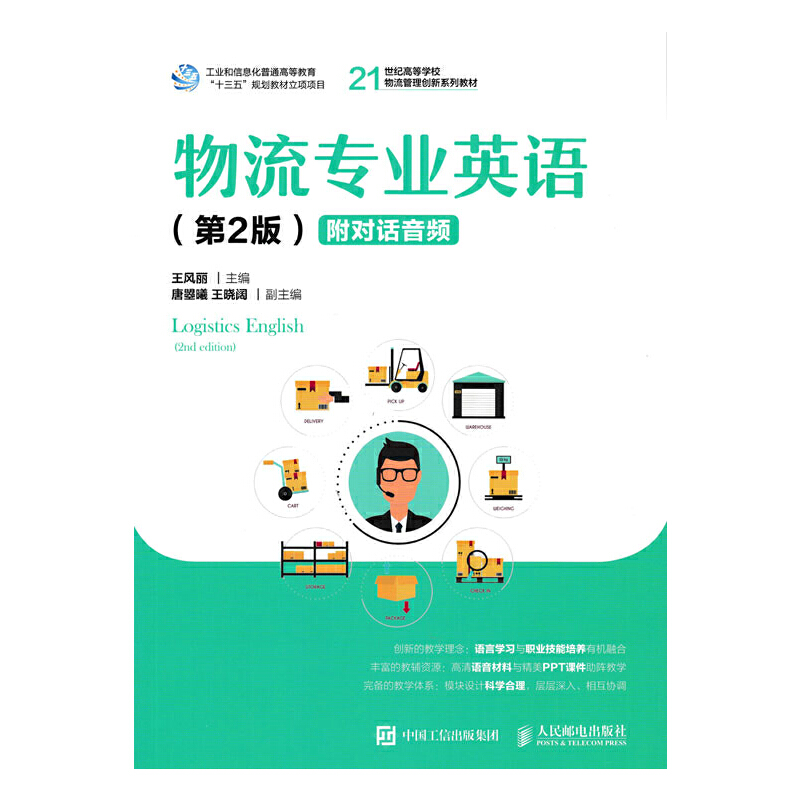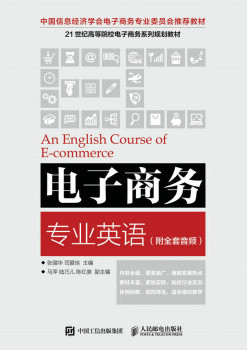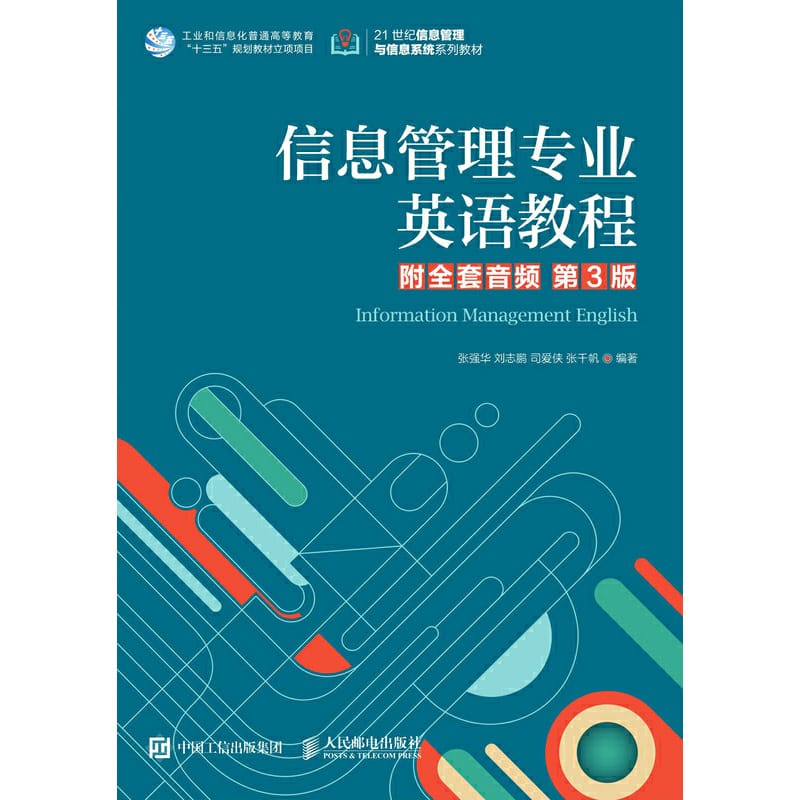物流专业英语(第2版) / 21世纪高等学校物流管理创新系列教材
定价:¥35.00
作者: 王风丽
出版时间:2017-08
出版社:人民邮电出版社
- 人民邮电出版社
- 9787115460424
- 2-4
- 233398
- 46212900-8
- 平装
- 16开
- 2017-08
- 297
- 176
- 英语
- 本科
内容简介
本书致力于把实用、典型、核心、前沿的物流业务知识传递给读者。全书共分3个模块。第1模块为基础篇(共3章),内容涉及物流概论及著名物流公司的介绍、物流商务礼仪;第2模块为专业篇(共11章),内容分别为仓储、采购、配送、运输、包装、国际货运代理、物流信息管理、供应链管理、第三方物流、逆向物流、物联网;第3模块为业务篇(共4章),内容涉及国际物流业务中所运用的相关文件。各章分别包含学习目标、课文、词汇、注释、案例分析、补充阅读、课后练习等内容。附录部分收集了物流术语。本书适合高等院校物流专业学生使用,也可供物流行业从业人员及相关人员学习参考。
目录
Module 1 Background Knowledge of Logistics
Chapter 1 A General Introduction
of Logistics 2
Objectives 2
Focus on 2
Text 2
1.1 The Definition of Logistics 3
1.2 Analysis of Logistics Definition 3
1.3 The Importance of Logistics 4
1.4 Main Activities of Logistics System 5
Notes 7
Exercises 7
Chapter 2 The Famous Logistics Companies 9
Objectives 9
Focus on 9
Text 9
Lead in 9
2.1 DHL China 9
2.2 FedEx 11
2.3 UPS 12
2.4 Maersk 14
2.5 COSCO 15
2.6 China Post (EMS) 16
Notes 18
Exercises 18
Chapter 3 Business Etiquette of Logistics 20
Objectives 20
Focus on 20
Text 20
Lead in 20
3.1 Personal Appearance 20
3.2 Common Ceremonial Reception 25
3.3 Etiquette in Different Parts of the World 27
Notes 31
Exercises 31
Module 2 Professional English of Logistics
Chapter 4 Warehousing 34
Objectives 34
Focus on 34
Text 34
Lead in 34
4.1 Role of Warehousing 34
4.2 Main Components of Warehousing 35
4.3 Types of Warehouses 35
4.4 Warehousing Activities 37
Notes 37
Exercises 38
Dialogue 39
Case Study 41
Supplementary Reading 41
Chapter 5 Purchasing 42
Objectives 42
Focus on 42
Text 42
Lead in 42
5.1 Definition of Purchasing 42
5.2 Role of Purchasing 43
5.3 Need of Purchasing 43
5.4 Decision of Purchasing 43
5.5 Purchasing Process 44
Notes 45
Exercises 46
Dialogue 47
Case Study 48
Supplementary Reading 49
Chapter 6 Distribution 50
Objectives 50
Focus on 50
Text 50
Lead in 50
6.1 Concept of Distribution 50
6.2 Significance and Effect of Distribution 51
6.3 Factors of Distribution 51
6.4 Operation Targets of Distribution 53
6.5 General Operation of Distribution 55
Notes 57
Exercises 57
Dialogue 59
Case Study 60
Supplementary Reading 61
Chapter 7 Transportation 62
Objectives 62
Focus on 62
Text 62
Lead in 62
7.1 Definition of Transportation 62
7.2 The Purpose of Transportation 63
7.3 Importance of Transportation 63
7.4 Transportation Modes 64
Notes 68
Exercises 68
Dialogue 69
Case Study 70
Supplementary Reading 70
Chapter 8 Packaging 72
Objectives 72
Focus on 72
Text 72
Lead in 72
8.1 Functions of Packaging 73
8.2 Types of Packaging 74
Notes 77
Exercises 77
Dialogue 78
Case Study 79
Supplementary Reading 79
Chapter 9 International Freight Forwarding 81
Objectives 81
Focus on 81
Text 81
Lead in 81
9.1 An Introduction to FIATA 82
9.2 Steps Performing International Freight Forwarders 82
9.3 Differences for Work as a Forwarder
between the Consignor and Consignee 83
9.4 Trade Terms of International Freight Forwarders 84
Notes 84
Exercises 85
Dialogue 86
Notes 87
Case Study 87
Supplementary Reading 88
Chapter 10 Logistics Information Management 90
Objectives 90
Focus on 90
Text 90
Lead in 90
10.1 General Introduction to Information Logistics 90
10.2 Logistics Information System 92
10.3 Role of Information Management 94
10.4 Bar(Retail Bar Coding Basics) 94
10.5 Pick-to-Light 96
Notes 97
Exercises 98
Dialogue 99
Case Study 101
Supplementary Reading 102
Chapter 11 Supply Chain
Management 103
Objectives 103
Focus on 103
Text 103
Lead in 103
11.1 Definition and Types of Supply
Chains 103
11.2 SCM and Logistics 104
11.3 Supply Chain Management: Analysis,Design, and Integration 105
Notes 106
Exercises 107
Dialogue 108
Case Study 109
Supplementary Reading 110
Chapter 12 Third Party Logistics (3PL) 112
Objectives 112
Focus on 112
Text 112
Lead in 112
12.1 An Overview of Third Party Logistics (3PL) 112
12.2 3PL Providers 114
12.3 Reasons for Growth of 3PL 116
Notes 116
Exercises 117
Dialogue 118
Notes 119
Case Study 120
Supplementary Reading 120
Chapter 13 Reverse Logistics 122
Objectives 122
Focus on 122
Text 122
Lead in 122
13.1 Definition and Activities 122
13.2 Reverse VS Forward Logistics 123
13.3 Challenges of Reverse Logistics 124
13.4 Leveraging the Power of Reverse Logistics 125
Notes 127
Exercises 128
Dialogue 128
Case Study 129
Supplementary Reading 129
Chapter 14 The Internet of Things 131
Objectives 131
Focus on 131
Text 131
Lead in 131
14.1 Definition of the Internet of Things 131
14.2 Historical Evolution of the Internet of Things 132
14.3 Importance of the Internet of Things 132
14.4 Global Watch 133
Notes 135
Exercises 136
Dialogue 136
Case Study 137
Supplementary Reading 138
Module 3 The Practice of Logistics English
Chapter 15 Business Letters 141
Objectives 141
Focus on 141
Text 141
Lead in 141
15.1 Introduction to Business Letters 141
15.2 Principals of Business Letter-Writing 142
15.3 Parts of a Business Letter 143
15.4 Business Letter Format 145
Samples 146
Exercises 148
Chapter 16 Contract 149
Objectives 149
Focus on 149
Text 149
Lead in 149
Samples 151
Exercises 153
Chapter 17 Bill of Lading 155
Objectives 155
Focus on 155
Text 155
Lead in 155
Samples 157
Exercises 159
Chapter 18 Letter of Credit 160
Objectives 160
Focus on 160
Text 160
Lead in 160
Samples 162
Exercises 163
附录 物流术语 166
References 174
Chapter 1 A General Introduction
of Logistics 2
Objectives 2
Focus on 2
Text 2
1.1 The Definition of Logistics 3
1.2 Analysis of Logistics Definition 3
1.3 The Importance of Logistics 4
1.4 Main Activities of Logistics System 5
Notes 7
Exercises 7
Chapter 2 The Famous Logistics Companies 9
Objectives 9
Focus on 9
Text 9
Lead in 9
2.1 DHL China 9
2.2 FedEx 11
2.3 UPS 12
2.4 Maersk 14
2.5 COSCO 15
2.6 China Post (EMS) 16
Notes 18
Exercises 18
Chapter 3 Business Etiquette of Logistics 20
Objectives 20
Focus on 20
Text 20
Lead in 20
3.1 Personal Appearance 20
3.2 Common Ceremonial Reception 25
3.3 Etiquette in Different Parts of the World 27
Notes 31
Exercises 31
Module 2 Professional English of Logistics
Chapter 4 Warehousing 34
Objectives 34
Focus on 34
Text 34
Lead in 34
4.1 Role of Warehousing 34
4.2 Main Components of Warehousing 35
4.3 Types of Warehouses 35
4.4 Warehousing Activities 37
Notes 37
Exercises 38
Dialogue 39
Case Study 41
Supplementary Reading 41
Chapter 5 Purchasing 42
Objectives 42
Focus on 42
Text 42
Lead in 42
5.1 Definition of Purchasing 42
5.2 Role of Purchasing 43
5.3 Need of Purchasing 43
5.4 Decision of Purchasing 43
5.5 Purchasing Process 44
Notes 45
Exercises 46
Dialogue 47
Case Study 48
Supplementary Reading 49
Chapter 6 Distribution 50
Objectives 50
Focus on 50
Text 50
Lead in 50
6.1 Concept of Distribution 50
6.2 Significance and Effect of Distribution 51
6.3 Factors of Distribution 51
6.4 Operation Targets of Distribution 53
6.5 General Operation of Distribution 55
Notes 57
Exercises 57
Dialogue 59
Case Study 60
Supplementary Reading 61
Chapter 7 Transportation 62
Objectives 62
Focus on 62
Text 62
Lead in 62
7.1 Definition of Transportation 62
7.2 The Purpose of Transportation 63
7.3 Importance of Transportation 63
7.4 Transportation Modes 64
Notes 68
Exercises 68
Dialogue 69
Case Study 70
Supplementary Reading 70
Chapter 8 Packaging 72
Objectives 72
Focus on 72
Text 72
Lead in 72
8.1 Functions of Packaging 73
8.2 Types of Packaging 74
Notes 77
Exercises 77
Dialogue 78
Case Study 79
Supplementary Reading 79
Chapter 9 International Freight Forwarding 81
Objectives 81
Focus on 81
Text 81
Lead in 81
9.1 An Introduction to FIATA 82
9.2 Steps Performing International Freight Forwarders 82
9.3 Differences for Work as a Forwarder
between the Consignor and Consignee 83
9.4 Trade Terms of International Freight Forwarders 84
Notes 84
Exercises 85
Dialogue 86
Notes 87
Case Study 87
Supplementary Reading 88
Chapter 10 Logistics Information Management 90
Objectives 90
Focus on 90
Text 90
Lead in 90
10.1 General Introduction to Information Logistics 90
10.2 Logistics Information System 92
10.3 Role of Information Management 94
10.4 Bar(Retail Bar Coding Basics) 94
10.5 Pick-to-Light 96
Notes 97
Exercises 98
Dialogue 99
Case Study 101
Supplementary Reading 102
Chapter 11 Supply Chain
Management 103
Objectives 103
Focus on 103
Text 103
Lead in 103
11.1 Definition and Types of Supply
Chains 103
11.2 SCM and Logistics 104
11.3 Supply Chain Management: Analysis,Design, and Integration 105
Notes 106
Exercises 107
Dialogue 108
Case Study 109
Supplementary Reading 110
Chapter 12 Third Party Logistics (3PL) 112
Objectives 112
Focus on 112
Text 112
Lead in 112
12.1 An Overview of Third Party Logistics (3PL) 112
12.2 3PL Providers 114
12.3 Reasons for Growth of 3PL 116
Notes 116
Exercises 117
Dialogue 118
Notes 119
Case Study 120
Supplementary Reading 120
Chapter 13 Reverse Logistics 122
Objectives 122
Focus on 122
Text 122
Lead in 122
13.1 Definition and Activities 122
13.2 Reverse VS Forward Logistics 123
13.3 Challenges of Reverse Logistics 124
13.4 Leveraging the Power of Reverse Logistics 125
Notes 127
Exercises 128
Dialogue 128
Case Study 129
Supplementary Reading 129
Chapter 14 The Internet of Things 131
Objectives 131
Focus on 131
Text 131
Lead in 131
14.1 Definition of the Internet of Things 131
14.2 Historical Evolution of the Internet of Things 132
14.3 Importance of the Internet of Things 132
14.4 Global Watch 133
Notes 135
Exercises 136
Dialogue 136
Case Study 137
Supplementary Reading 138
Module 3 The Practice of Logistics English
Chapter 15 Business Letters 141
Objectives 141
Focus on 141
Text 141
Lead in 141
15.1 Introduction to Business Letters 141
15.2 Principals of Business Letter-Writing 142
15.3 Parts of a Business Letter 143
15.4 Business Letter Format 145
Samples 146
Exercises 148
Chapter 16 Contract 149
Objectives 149
Focus on 149
Text 149
Lead in 149
Samples 151
Exercises 153
Chapter 17 Bill of Lading 155
Objectives 155
Focus on 155
Text 155
Lead in 155
Samples 157
Exercises 159
Chapter 18 Letter of Credit 160
Objectives 160
Focus on 160
Text 160
Lead in 160
Samples 162
Exercises 163
附录 物流术语 166
References 174










